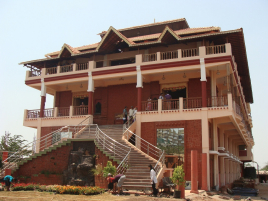Beautiful Eco-Friendly Temple Opens on Outskirts of Pune
By Madhava Smullen | Apr 03, 2011

An incredible 25,000 devotees attended the opening of a brand new temple in Ravet on the outskirts of Pune, India this March 21st through 22nd—including Gopal Krishna Goswami, Lokanath Swami, Radhanath Swami, Chandramauli Swami, Bhakti Vidyapurna Swami, and many other senior devotees from ISKCON temples across Maharastra.
On the first day of the festival a fire ceremony was performed by Bhakti Vidyapurna Swami, followed by an “Abhisekha” in which the local devotees bathed the Sri Sri Gaura Nitai Deities they had been worshipping in their ashram, as well as new marble Deities of Sri Sri Radha Govindji made in Jaipur, the Deity capital of the world.
VIP guests Gopal Krishna Goswami, Lokanath Swami and Radhanath Swami enlightened attendees with inspirational classes, while Lokanath Swami held a second Abhishek and Kirtan program the following day.

ISKCON launched in Nigdi—a suburb of Pune next to the Ravet area where the new temple is located—back in 1994, when local devotee Gopalacharya Dasa began holding programs in his house.
“The community was very small—consisting of only about five to ten devotees,” says Gopati Dasa, manager of the new temple, dubbed Sri Govind Dham. “But the location felt right. Nigdi is part of the industrial town of Pimpri Chinchvad, which is one of the richest municipalities in Asia. And it’s only around ten kilometers away from the holy place of Dehu, where the revered Vaishnava saint and disciple of Sri Chaitanya Mahaprabhu Sri Tukaram Maharaj lived.”
Sure enough, the number of devotees grew to hundreds over the years, and with loving care and guidance from Radhanath Swami and the devotees of ISKCON Chowpatty, the Nigdi community continued to thrive.

“The youth in Pimpri Chinchvad were the quickest to grasp the philosophy of Krishna consciousness, and many of them came forward to dedicate their lives to Srila Prabhupada’s mission,” Gopati says. “With their enthusiasm we started a brahmachari (celibate student) ashram in 2002, in a rented bunglow. We also held congregational programs in another rented premises.”
Soon, the desire grew amongst the devotees to purchase a private piece of land for ISKCON, where they could gather to serve the Lord and practice Krishna consciousness in the strict, dedicated way Radhanath Swami had taught them.
In 2003, all the devotees came together to contribute funds and purchase a one-acre piece of land in an affluent residential area.

On March 21st 2005, Radhanath Swami performed the Bhumi Pujan, or groundbreaking ceremony for a brand new temple on the newly purchased land. The congregation generated the funds for the temple locally, implementing schemes such as Brick-by-Brick—where 100 rupees could be donated per brick—and Mark Your Square—where 2,100 rupees could be paid for one square foot.
The construction began in February 2009, and now on March 21st 2011, exactly six years after Radhanath Swami had performed the groundbreaking ceremony, the new temple has been inaugurated.
And it’s a breathtaking achievement.
Three storeys high, made of brick and painted in warm colors, it doesn’t look like your typical Indian temple—its architecture is a more homey combination of modern and oriental styles. And the building materials are unique, reflecting an eco-friendly approach and integration with nature.
“We used laterite bricks, which are renowned as breathing bricks, while the roof is of Manglorean tiles, which are made from clay and weigh 2.5 kilograms each,” says Gopati Dasa. “The tiles and bricks automatically condition the temperature in the temple hall. We’ve also used a lot of wood in our design—the wall cladding is made with Pine, and the flooring is authentic Gujarati Teak.”
The temple hall is a marvel in itself, with a 46-foot-high ceiling, and an area of 4,000 square feet, where around 800 devotees can sit comfortably. Its roof is equally broad, and specially designed so that it is balanced without the need of any central support pillars. The temple hall’s walls are intricately carved pine wood, and the spacious wooden altar is also meticulously carved, with large brass domes molded from a very unique recycled material—old brass and copper kitchen utensils donated by the community.
It’s a beautiful home for Sri Sri Gaura Nitai and Radha Govindji, and a wonderful place of worship for Ravet’s 800-strong congregation and thirty brahmacharis.
“With the attraction of this newly constructed temple, we expect the number of devotees to double this year,” says Gopati.
The large congregation is a vibrant one, too—they gather every Thursday and Sunday for “Satsang” programs, while some attend the full morning program and others the Bhakti Shastri study course on offer. There are also four different summer programs that draw fifty students each to stay at the temple and practice devotional service.
“We have also started Namahatta programs at ten places around Nigdi, and offer Baal Samskar Kendra—which are value education programs for children—throughout the year,” Gopati says. “Corporate preaching and book distribution are also big focuses for us: each year, a new record is set for distributing Srila Prabhupada’s books in the neighboring industrial town.”
Of course, the congregation and devotees of Sri Govind Dham are also kept busy with devotional festivals: every year, the community celebrates Jagannath Ratha Yatra, drawing around 30,000 participants, as well as other major festivals such as Janmashtami, Radhashtami, Ramnavami, Ashadhi Ekadashi, and Gaura Purnima.
“In the future, we hope to also construct an administrative building, and a permanent brahmachari ashram for our students to stay in,” says Gopati. “But most of all, we are just very happy to try to serve Srila Prabhupada’s movement by spreading Krishna conscious philosophy under the guidance of all the Vaishnavas.”















